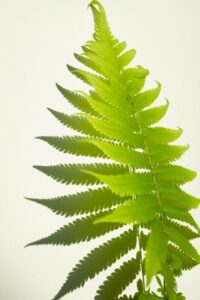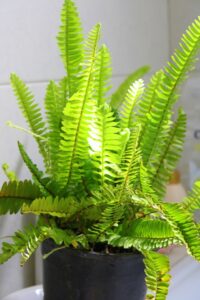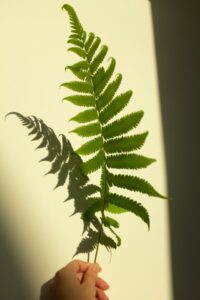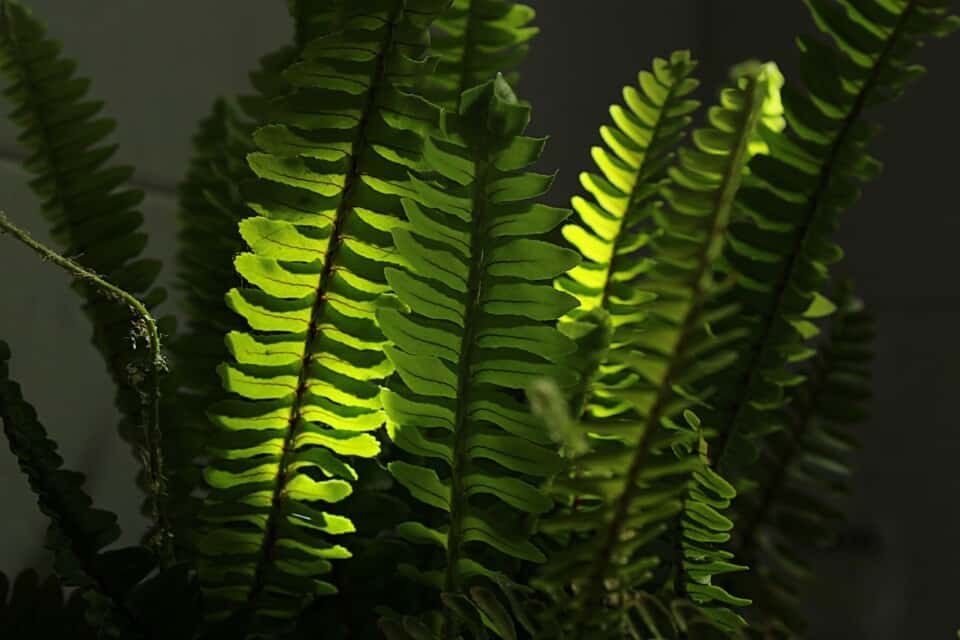Some links in the post are affiliate links and I get a commission from purchases made through some links found in the post.
Most people are a bit hesitant to grow tropical plants in their homes. And I understand this fear.
How are you supposed to bring in a plant that thrives in the tropics only for you to house it in a fluorescent-lit home?
How can that work? The Boston fern, which is native to the Americas, Polynesia, and Africa, is not a plant you need to fear.
Sure, it does well in tropical areas. But as many gardeners, including me, have proven, it can do well in the home too!
The Boston fern does not need much sunlight. It needs medium and bright indirect light for at least two hours in the spring and fall. In the summer it needs a semi shaded location to avoid the intense light of the sun.
And in this guide, I will break down the specific kind of light it needs.
I will also get into how you can diagnose lighting problems and what you can do about them. You’ll get to see why it’s possible to grow this amazing plant right in your home:
What Type of Light Does My Boston Fern Need?
Before I get into the kind of light your Boston fern needs, how about I break down the types of light?
I often find that this differentiation perturbs some gardeners, especially newbies. After all, if I tell you to place your plant in bright and indirect light, what does that even mean?
Let’s cover the general types of light first and shed some light on this categorization (notice the pun?)
1) Direct Light
As the name suggests, this is light that comes directly from the sun’s rays – no protection whatsoever. As such, you can imagine that the light is quite intense.
Most plants do not enjoy such light and will wilt and even die in such conditions. However, succulents like cacti enjoy this light as they have features to withstand direct exposure.
2) Bright and Indirect Light
 When growing most houseplants, you will notice that most guides dictate that this is the best light for the plant. But what exactly is bright indirect light?
When growing most houseplants, you will notice that most guides dictate that this is the best light for the plant. But what exactly is bright indirect light?
Let me paint a picture for you. Assume you are standing by an east-facing window on a hot sunny morning. The sun’s rays would hit you directly.
Now assume you are standing by a north-facing window. Would the sun’s rays hit you? Not at all. But the room would be bright enough. That is the definition of bright and indirect light. Most plants enjoy such exposure.
3) Medium Light
Have you heard of this type of light? Let’s go back to our window analogy. Instead of standing by the east-facing window on a sunny morning, let’s move to the middle of the room.
The sun’s rays will not hit you in this position, but the room will still be bright. That’s medium light. Many plants also do well in such lighting.
4) Low Light
We often emphasize the need for light for houseplants. But some don’t need as much light as others. Low-light-loving plants do well away from bright light and can even grow in dark nooks.
Rather than stand in the middle of the east-facing room, assume you are in a north-facing room. And not near the window but in the corner.
That’s an excellent example of low light. Some plants even grow in bathrooms with a tiny window casting some light into selected spots in the room.
Of course, with such low light conditions, these plants take a while to grow. But they are ideal for homes with limited space or limited access to light.
Now, let’s get back to our question. What kind of light does the Boston fern need?
The answer is bright and indirect light. You can place the plant in a room that receives bright and indirect light all day.
Or you can even place it in a spot that receives direct light as long as the exposure does not exceed an hour each day. The plant does not react harshly to filtered light in the morning and afternoon.
If you’re enjoying this article, check out our article on what is the ideal humidity for a Boston fern.
How Much Light Does a Boston Fern Need?
Okay, so we now know the type of light that works for the Boston fern. But how much of this light should it receive? We break this down in terms of seasons.
The plant needs at least two hours of sunlight a day in the spring and fall. Of course, we are referring to the bright and indirect light we earlier mentioned. The plant should not be in direct light for more than an hour a day.
In the summer, the sun is much hotter. As such, you must ensure it only gets bright and indirect light. If it must have access to direct light, limit this to half an hour each day.
Why does lighting matter? Often, we talk about plant’s lighting needs but don’t get into why this is essential to their growth. So, let’s get into that a bit.
Plants need light, water, and carbon dioxide to make their food through a process known as photosynthesis. From this process, the plants make sugars essential in forming their leaves and stems.
Ergo, without light, photosynthesis cannot occur, and the plant cannot grow. That’s when plants start looking leggy, limp, and diseased.
But what type of light does the Boston fern need? To get it right, we must relate the plant to its native habitat – the tropical forest.
This environment is warm, humid, and filled with flora of different kinds. The Boston fern grows hidden among the rest of the plants.
And because it cannot grow to the heights of the tallest species, it survives on the filtered light from the canopy.
The plant uses this light to photosynthesize and grow bigger. And that’s why you must replicate the same conditions for your fern to thrive.
What Happens If Your Boston Fern Gets Too Little Light?
Does it matter whether you adhere to the plant’s lighting needs or not? It turns out that it matters a lot! While the Boston fern does not need direct sunlight, it does not take too well to getting low light.
Such conditions deprive it of the ability to make enough food to support its growth. Moreover, they leave it weak, exposing it to a myriad of pests and diseases. You can tell that your plant does not get enough light if:
Its Leaves Start Falling Off
 Leaves fall off plants for many reasons. If the leaves falling off are mature, it’s part of the aging process. The old leaves fall out to create room for the new foliage.
Leaves fall off plants for many reasons. If the leaves falling off are mature, it’s part of the aging process. The old leaves fall out to create room for the new foliage.
However, the leaves must be mature. Thus, if you notice younger leaves falling off the plant, it’s a sign that all is not well.
How does leaf dropping relate to low light? It comes down to the production of sugars via photosynthesis.
If the plant does not receive adequate light to allow it to make these sugars, it ends up with reduced amounts. And these cannot support leaf maturity. The leaves thus start falling off the plant.
Loss of Color
Lush green foliage is a sure sign that your plant has all its needs met. But if the foliage hue starts to fade, you can tell that the plant is facing some issues.
While the problems can relate to other unfulfilled needs like watering, humidity regulation, and pest infestation, it’s always good to consider that lighting could also be a factor.
Poor lighting reduces the plant’s ability to make food to sustain its leaf and stem growth. As a result, the foliage appears faded.
How To Fix Low Light Issues
The easiest way to deal with low light conditions is to locate the plant in a sunnier spot in the home. For example, you could move the plant to an east-facing room.
In that case, it would receive bright morning sun and still get access to bright light in the day.
Alternatively, you can place it in a west-facing room where it can access some afternoon sun while still getting bright light the rest of the time. That should fix the lighting issue to a great extent.
You should be careful when increasing the plant’s light exposure. Too much light can also be an issue, as I have detailed below:
You may also like: What are the benefits of a Boston fern
What Happens If Your Boston Fern Gets Too Much Light?
In most things in life, you must practice moderation. Even when something is beneficial, you must know when to pump the brakes.
Otherwise, you end up going all in, which can lead to issues here and there. As we mentioned earlier, the Boston fern grows in the tropics, shaded by taller plants.
It thus does best when receiving dappled light. But in the home, we don’t have canopies to protect the fern from this direct light.
And you might end up leaving the plant in a spot where the light is too much. What happens when you give it direct light?
Its leaves start browning
Did you know that Boston fern leaves can burn? If you leave them exposed to the sun for too long, they burn.
Their edges start curling and browning, and before you know it, the whole leaf gets damaged. It’s likelier when the plant gets exposed to the afternoon sun as the light tends to be harsher.
How to Fix Too Much Lighting
I would like to give you hope by saying that you can undo the effects of the hot sun on your Boston fern.
But unfortunately, once the leaf shows browning, the extent of the damage is permanent. All you can do is prevent more leaves from suffering a similar fate. And how do you do this?
First, avoid placing your plant near south-facing windows as these receive longer and harsher hours of sunlight.
Instead, move it near an east or west-facing window where direct light is only available a few hours a day. Even then, protect the plant by using sheers on the windows.
Secondly, ensure your plant gets enough water. Sometimes, the curling and browning result from underwatering and too much light.
As the plant loses water, photosynthesis becomes harder to accomplish. Thus, find a way to balance the watering and lighting.
Can Boston Ferns Grow in Artificial Light?
We’ve talked about different kinds of light and discussed the best option for the Boston fern. But what happens if you live in an area where bright indirect light is not feasible?
Or what happens when winter comes and the lighting reduces? Can you supplement the lighting with artificial light? The answer is yes!
While sunlight is great, you cannot count on it year-round. Thus, you can always seek an alternative in the form of artificial lights.
How To Grow A Boston Fern Using An Artificial Light
 First, you need to understand the type of light the Boston fern needs to grow. In this case, we are not referring to bright and indirect light.
First, you need to understand the type of light the Boston fern needs to grow. In this case, we are not referring to bright and indirect light.
Instead, we are leaning on wavelengths. Your plant needs blue and red wavelength lights to promote its proper growth. And you can get that from:
- Fluorescent lights: These are the cheapest options. Go for the full-spectrum choices,
- Incandescent lights: These emit a lot of heat. You should not place them too close to the plant as that can trigger a temperature issue,
- LED lights: These are the best when it comes to energy efficiency,
- Halogen lights: These also emit a lot of heat, and you should place them far from the plant, and
- Horticultural grow lights: These are a good choice if you want full spectrum lights.
Any of these options should work the magic. All you need is to mount the light on a standing lamp and aim it at the plant.
Then leave the light on for 16 hours a day to mimic daytime and night time. If your plant gets sunlight, you can alter the artificial light settings accordingly.
Final Thoughts
Are you still concerned about growing a Boston fern in your home? There’s no reason not to give it a go.
You can promote its growth using sunlight or choose artificial light to boost the natural light in your home. As long as you don’t deprive the plant of light or give it more than it needs, you should have a thriving plant in no time.
Happy Gardening!
Before you go, here are some more related articles I encourage you to read below to help solve more of your gardening issues:
How To Save A Dying Staghorn Fern

